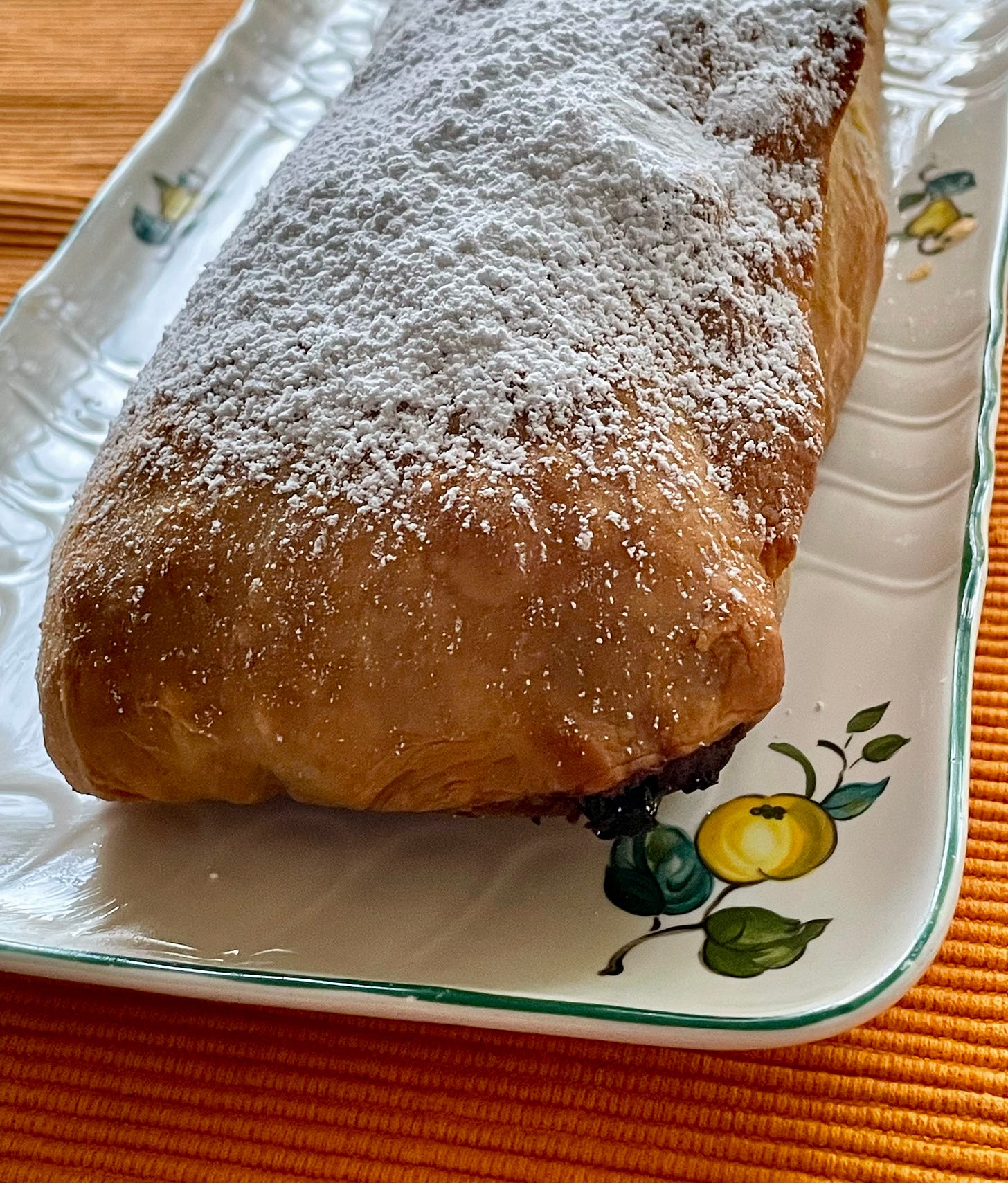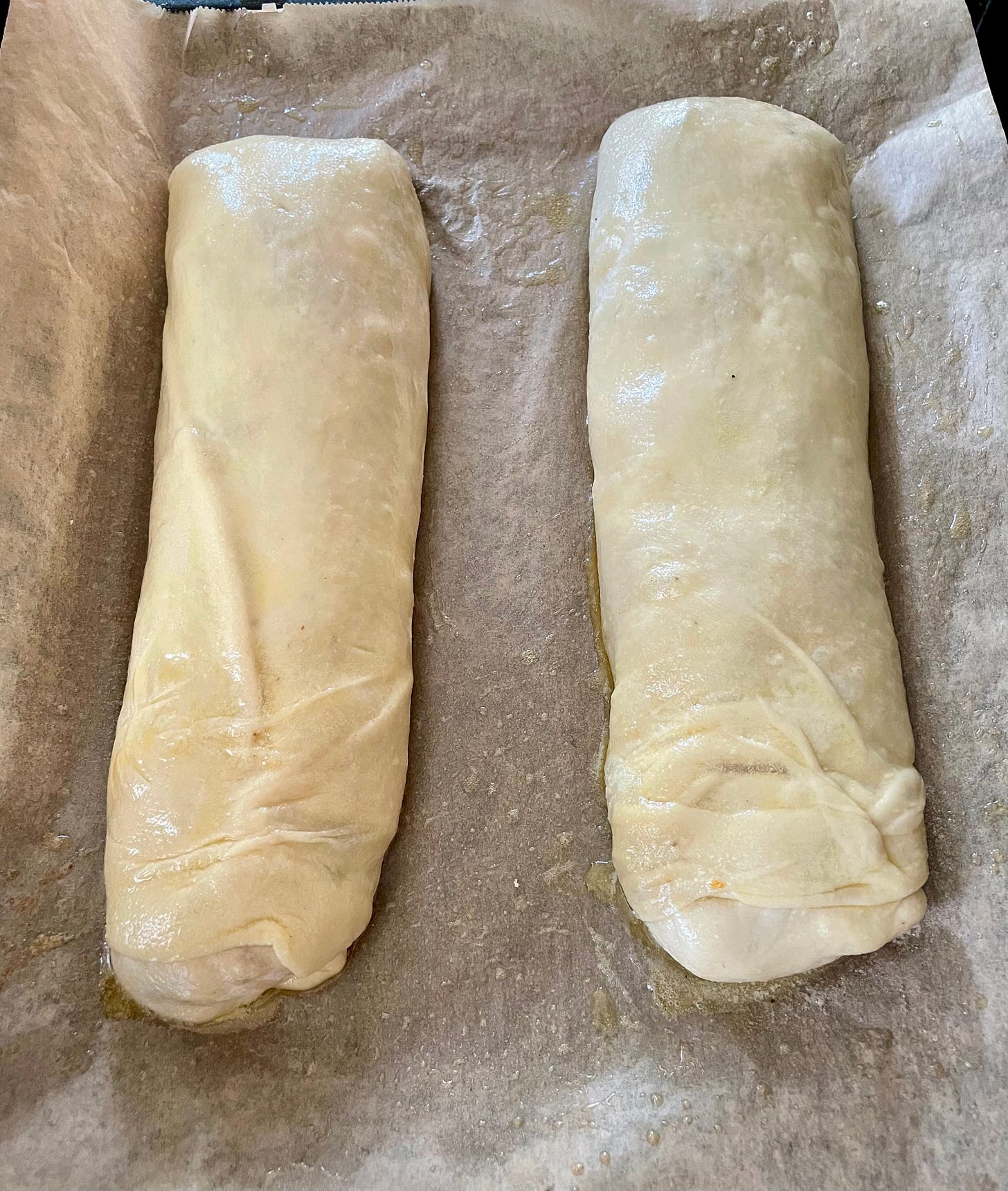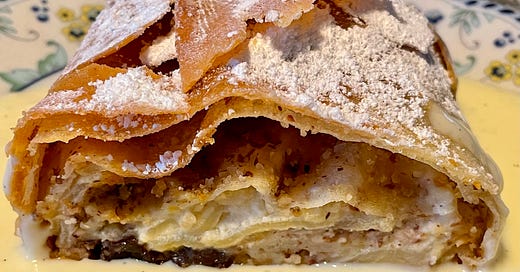The Secrets Behind Perfectly Crisp Apfelstrudel
Join me on a journey to uncover the unique techniques that make this traditional dish a delightful paradox of textures.

The Strudel That Changed Everything
I wasn’t born into a family of bakers. My grandmother’s hands didn’t flutter like birds over dough, and while my mother was an extraordinary cook—her meals the stuff of legend—baking wasn’t her passion. She produced German “housewife” standards impeccably, but it was always more of a duty than an art for her.
So when I first encountered Apfelstrudel, it wasn’t in a family kitchen but during our first ski holiday in the Austrian Alps. I can still feel the crisp mountain air on my cheeks, the slight burn in my legs from a day spent on the slopes, and the heady mix of exhaustion and exhilaration that followed.
And then came the Strudel.
At first glance, it looked like puff pastry, its golden-brown surface blistered with crispness. But the moment I took a bite, I knew this was something else entirely.
It wasn’t the buttery richness of puff pastry, smooth and pliant with a hint of chew. This dough was crisp, almost crackling, with a flavor that spoke of roasting rather than baking.
A Mystery Wrapped in Layers
Inside, the filling was a revelation. It wasn’t simply sliced apples tucked into the dough. No, this was something closer to apple compote—a harmonious blend of softened fruit, raisins, and nuts, sweet but not cloying, with a whisper of cinnamon and a hint of lemon. The filling had melded into itself, moist and lush, yet somehow, miraculously, the dough remained dry and crisp.
Have you ever tried baking something with a wet filling? Puff pastry, for instance, almost always succumbs to the moisture, its layers turning sodden unless you blind bake or reinforce them with a protective barrier. And yet here was this Strudel, baked whole, dough wrapped around a filling so succulent it practically begged to seep through. Not only did it hold its integrity, but the layers inside were still distinct, their crispness contrasting beautifully with the tender apples.
I was mesmerized.
The Wonder of Discovery
I remember leaning over my plate, examining the layers like a jeweler appraising a rare gem. How did they do it?
How could something be so crisp and delicate on the outside yet cradle such a luscious, moist filling within? The Strudel was doused in warm Vanilla Sauce—a silken accompaniment so decadent it should have been too much. Yet it wasn’t. Instead, it heightened every flavor and texture, drawing attention to the contrasts while bringing them into harmony.
That first taste wasn’t just a culinary experience. It was a kind of awakening.
A Dance of Technique and Mystery
Back home, I couldn’t stop thinking about it. I tried to recreate it, but my first attempts were a comedy of errors. The dough tore. The filling spilled out. Everything turned soggy. I didn’t know then what I know now: that Strudel dough isn’t just any dough. It’s a feat of engineering, requiring patience, skill, and a touch of daring.
Have you ever worked with a dough so elastic it feels alive? Strudel dough must be stretched, not rolled, until it’s translucent enough to read through. It’s a slow process, one that demands you let go of your perfectionism and trust the process. I’ve learned that the dough needs time to rest before you even begin to stretch it. And as it rests, so must you.
It’s not unlike the quiet moments of reflection in a canyon—those pauses where you stop to take in the scope of the landscape, to marvel at the layers that tell the story of time. The dough, much like life, unfolds best when approached with patience and care.
The Layers of a Canyon
As I mastered the art of Strudel, I found myself returning to that memory in the Alps. It wasn’t just the taste that captivated me. It was the layers, the interplay of contrasts, the way the simple became extraordinary.
Much like my Canyon Model, Apfelstrudel speaks to the beauty of complexity. The crisp, golden layers of dough are the resilient surface we show the world, while the tender filling represents the softness and vulnerability within. The Vanilla Sauce? Perhaps it’s the sweetness of connection, the thing that brings it all together.

A Recipe Worth Sharing
And now, I invite you to try your hand at making Apfelstrudel. Don’t worry about perfection; it’s the journey that matters. Whether your first attempt is a masterpiece or a mess, you’ll discover something about yourself in the process.
Apfelstrudel
For the dough:
250g (2 cups) all-purpose flour
1/8 tsp salt
1 egg
100ml (7 tbsp) lukewarm water
30ml (2 tbsp) vegetable oil
For the filling:
6-8 tart apples, peeled and thinly sliced
50g (1/4 cup) sugar
1 tsp cinnamon
Zest and juice of 1 lemon
50g (1/4 cup) raisins (optional)
100g (1/2cup) coarsely grated nuts (Hazelnuts, Almonds, Pecan, Walnuts or a mixture)
50g-100g (1/4-1/2 cup) melted butter, for brushing
Instructions:
Make the dough:
Combine the flour and salt in a bowl. Add the egg, water, and oil, kneading until smooth. Coat the dough ball with oil and wrap it in cling film. Cover the dough and let it rest at a warm place for 30 minutes.
Prepare the Oven:
Preheat your oven to 200° (standard) , 180° (Convection) (370°-400°F).
Make the filling:
Rub the sugar with the lemon zest until incorporated.
In a bowl, combine the apples, lemon-sugar, cinnamon, raisins, and nuts.
Roll out the dough:
Prepare to big kitchen towels or another piece of linen on a flat surface. Dust it generously with flour.
Start by rolling the dough out as thinly as possible. It should have a rectangluar shape.
Once you cannot possibly roll it out more, gently insert the backs of your hands under the dough and start stretching it (like you would do with a pizza), letting it glide over the backs of your hands while you gently stretch those apart, with it stretching the dough thinner and thinner.
I have once read that the dough is thin enough when you can read this mornings paper through it. That might stretch it a bit too far, but you get the gist of this. The end measure is somewhere around 400 by 600 mm.
Let the lower part of the Strudel Dough fall down over your tableedge to prevent it from shrinking.
Shape the Strudel
Prepare the Dough:
Lightly baste the entire surface of the rolled-out dough with melted butter.
Apply the Filling:
Spread the filling onto 1/3 to 1/4 of the dough's total surface area, from the top.
Leave a 5–7 cm (2-3 inch) border on each side and at the top edge to help seal the strudel later.
Apply a layer of toasted breadcrumbs to the designated area of the filling to absorb excess liquid.
Evenly spread the prepared filling over the nut and spice layer.
Roll the Strudel:
Using the kitchen towel or cloth, carefully begin rolling the dough from the filling side.
As you roll, lightly brush the exposed dough with melted butter to ensure the layers remain flaky and crisp during baking.
Seal the Strudel:
Continue rolling until all the filling is enclosed.
Once the filling is rolled up, make sure that the entire rest of the dough to be rolled up is brushed with melted butter to prevent sticking and to promote even browning.
Continue rolling up the Strudel until the end of dough. For best results the Strudels seam should be at the bottom.
Secure the Edges:
Fold the ends of the dough underneath the strudel to seal the edges and prevent the filling from leaking during baking.
Brush the top of the strudel with melted butter
Your strudel is now ready to bake.
Bake
Bake at 180°C (Convection) 200° (Standard)(400°F) for about 30–45 minutes until golden brown.
Serve:
Dust with powered sugar. Serve warm, draped in Vanilla Sauce, and savor each bite.
Mostviertler Apple Strudel (a more luxurious filled variant)
Ingredients for 4 servings:
Strudel Dough:
250 g (2 cups) flour
1/8 l (1/2 cup) lukewarm water
1 Egg
1 pinch of salt
Filling:
60 g (1/4 cup) sugar
Zest of 1 Lemon
60 g (1/4 cup) butter
2 egg yolks
150 g (5.3 oz) dry (let they whey drain) Quark or Creme Fraiche, Schmand or Sour Cream
1 tablespoon cream
6-8 tart apples, peeled and thinly sliced
50 g (1.8 oz) raisins
50g (1/4 cup) finely chopped hazelnuts
50g (1/4 cup) finely chopped almonds
1/4 teaspoon Cinnamon and a pinch each nutmeg, clove, star anise and ginger
Zest of 1/2 Orange
A splash of lemon juice
Preparation
Mix nuts and spices:
Mix the coarsly ground nuts (pecan or walnuts are ok too) with a spices and rub in the zest of one orange.
Mix Sugar and Lemon Zest:
Rub the freshly grated lemon zest into the sugar to aromatized. This will ensure that the lemon flavor distributes evenly everywhere.
Prepare the dough:
Mix the flour with water, 1 egg and salt to form an elastic dough. This can be done in a food processor with a paddle attachement. Do not overmix. Coast the ball of dough with oil and fold in cling film. Let it rest in a warm place for 30 Minutes.
Make the filling:
Cream the butter, sugar, and egg yolks together until fluffy. Stir in the quark (or whatever you are using a substitute) and cream.
When the cream has come together nicely add the raisin and finally the peeled, thinly sliced apples.
Roll out the dough:
Prepare to big kitchen towels or another piece of linen on a flat surface. Dust it generously with flour.
Start by rolling the dough out as thinly as possible. It should have a rectangluar shape.
Once you cannot possibly roll it out more, gently insert the backs of your hands under the dough and start stretching it (like you would do with a pizza), letting it glide over the backs of your hands while you gently stretch those apart, with it stretching the dough thinner and thinner.
I have once read that the dough is thin enough when you can read this mornings paper through it. That might stretch it a bit too far, but you get the gist of this. The end measure is somewhere around 400 by 600 mm.
Let the lower part of the Strudel Dough fall down over your tableedge to prevent it from shrinking.

Shape the Strudel
Prepare the Dough:
Lightly baste the entire surface of the rolled-out dough with melted butter.
Apply the Filling:
Spread the filling onto 1/3 to 1/4 of the dough's total surface area, from the top.
Leave a 5–7 cm (2-3 inch) border on each side and at the top edge to help seal the strudel later.
Add the Nut and Spice Mixture:
Sprinkle half of the nut and spice mixture evenly over the section of dough designated for the filling.
If the filling is particularly moist, add a layer of toasted breadcrumbs to absorb excess liquid.
Layer the Filling:
Evenly spread the prepared filling over the nut and spice layer.
Sprinkle the remaining nut and spice mixture over the filling for added texture and flavor.
Roll the Strudel:
Using the kitchen towel or cloth, carefully begin rolling the dough from the filling side.
As you roll, lightly brush the exposed dough with melted butter to ensure the layers remain flaky and crisp during baking.
Seal the Strudel:
Continue rolling until all the filling is enclosed.
Once the filling is rolled up, make sure that the entire rest of the dough to be rolled up is brushed with melted butter to prevent sticking and to promote even browning.
Continue rolling up the Strudel until the end of dough. For best results the Strudels seam should be at the bottom.
Secure the Edges:
Fold the ends of the dough underneath the strudel to seal the edges and prevent the filling from leaking during baking.
Brush the top of the strudel with melted butter
Your strudel is now ready to bake.
Bake
Bake at 180°C (Convection) 200° (Standard)(400°F) for about 30–45 minutes until golden brown.
Serve:
Dust with powered sugar. Serve always warm (re-heat if necessary), draped in Vanilla Sauce, and savor each bite. Of course does such a strudel matches as well with a scoop of vanilla ice cream.
Let these recipes take you on your own journey, whether it’s a walk down memory lane or an adventure into uncharted territory. If this story and recipe spoke to you, share it with someone who might find joy in the layers of Strudel—and life.
Guten Appetit.
This newsletter is free for all. Sign up so you won’t miss a post, if you haven’t already.
❤️ If you find this piece meaningful, consider clicking the heart at the top or bottom of the post. It helps others discover this newsletter and brightens my day.
Bringing you these recipes and sharing the culinary stories behind them is a true passion of mine.
Each twist, tweak, and taste test comes with the joy of creativity—and yes, a little bit of cost, too. If this recipe resonated with you and added a touch of nostalgia or delight to your day, I’d be incredibly grateful if you’d consider leaving a tip. Or, better yet, indulge in a monthly or yearly subscription to support this publication.
Your generosity helps keep these flavors alive and ensures I can continue exploring, experimenting, and sharing them with you.
This article was previously published on Medium






Oooh, I am going to give this a go! Thank you for sharing these lovely recipes
Delicious! I have fond memories of stretching dough for apfelstrudel with my grandmother once. Thanks for the tip to stretch it so thin. My husband ordered apfelstreudel at least once a day when we cycled along the Danube a few years ago. He’ll love this. I saved it for future reference. Thanks Jay!